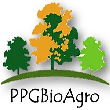Banca de DEFESA: DANIELE PAULA MALTEZO
Uma banca de DEFESA de MESTRADO foi cadastrada pelo programa.DISCENTE : DANIELE PAULA MALTEZO
DATA : 20/01/2021
HORA: 08:00
LOCAL: Alta Floresta, MT.
TÍTULO:
Genetic Diversity and Cytogenotoxicity of Copaifera langsdorffii Desf. (Fabaceae) native from the Amazon Mato-Grossense
PALAVRAS-CHAVES:
Copaiba, Genetic variability, ISSR.
PÁGINAS: 77
GRANDE ÁREA: Ciências Biológicas
ÁREA: Genética
SUBÁREA: Genética Vegetal
RESUMO:
The Amazon Forest is the largest tropical forest in the world, with 60% belonging to the Brazilian territory, one third of the forest is located in the state of Mato Grosso. It is estimated that about 20% of all the planet's biodiversity is found in the Amazon. Among the species present in the Amazon, we highlight the Copaifera langsdorffii Desf., exploited mainly for the extraction of its oil-resin and wood, and also to be used in folk medicine in the treatment of various diseases. Inadequate management of C. langsdorffii, as well as forest fragmentation, can cause a decrease in the number of individuals in the populations, which in the long run can cause the loss of genetic variability. This study aimed to perform the molecular characterization of 27 individuals of C. langsdorffii collected in the Amazon located in Mato Grosso state, Brazil, and to evaluate the toxic, cytotoxic and genotoxic potential of the species. For evaluation of genetic diversity, 12 ISSR primers were used, which amplified 106 fragments, 98.11% of which were polymorphic. The content of polymorphic information (PIC) of each primer varied between 0.45 and 0.81. The average dissimilarity found was 0.49. The greatest genetic variability is found within the groups and not between them. The percentage of polymorphism, values of genetic dissimilarity and indexes of genetic diversity, indicate that there is high genetic variability among C. langsdorffii individuals, suggesting that ISSR primers are efficient in detecting polymorphism in this species, and that the population has the potential to compose conservation programs and the ability to integrate germplasm banks. The assessment of toxic, cytotoxic and genotoxic potential was performed using the Allium cepa test. The aqueous extracts (infused and decocted) obtained from the stem bark and leaves of C. langsdorffii were evaluated, with five different concentrations and two controls, with distilled water (negative control) and glyphosate at 1% (positive control). The growth of the root system (CSR), the mitotic index (MI), and the frequency of chromosomal changes and / or abnormalities in the phases of cell division were evaluated. The greatest reductions in CSR were found in decocted extracts (stem bark and leaves). For the stem bark, both extracts at concentration of 0.032 mg mL -1 showed lower MI. The concentrations 0.002 mg mL-1 of the infused bark extract and 0.004 mg mL-1 of the decocted leaf extract showed 4.19 and 3.55% of cell aberrations respectively, followed by the positive leaf control with 5.71%. The results showed the toxic, cytotoxic and genotoxic potential of the aqueous extracts of C. langsdorffii on the test organism.
MEMBROS DA BANCA:
Presidente - 32143004 - ANA APARECIDA BANDINI ROSSI
Interno - 70141009 - OSCAR MITSUO YAMASHITA
Externo ao Programa - 292282001 - JULLIANE DUTRA MEDEIROS
Externo ao Programa - 221762011 - JULIANA DE FREITAS ENCINAS DARDENGO
Externo à Instituição - ANDREIA BARCELOS PASSOS LIMA GONTIJO - UFES



